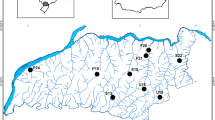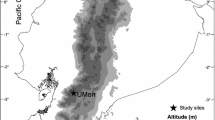Abstract
The presence of different kinds of leaf packs (native or alien) and environmental gradients can affect the composition and abundance of macroinvertebrate assemblages in freshwater ecosystems, but little is known about the interactive effects. Here, we investigated (1) how environmental gradients could influence leaf packs macroinvertebrates and (2) which was the chief factor (among water quality, mass loss of leaf packs, and flow regime) affecting macroinvertebrate assemblages in impaired streams. We analyzed leaf packs in six sites in impaired streams, characterized by wastewater discharges and dominated by pollution-tolerant macroinvertebrate species. Using principal component analysis, we defined two environmental gradients as follows: a water quality gradient, related to anthropogenic alteration, and a hydromorphological gradient, mostly related to the catchment features. Our results pointed out that, in the tested conditions, biological metrics, such as functional groups and taxa richness, were chiefly influenced by the water quality gradient, while different leaf types in packs influenced the total taxa richness, but did not cause significant variation in the distribution and abundance of macroinvertebrate functional groups. On the contrary, the mass loss differed for different leaf types and was related to the stream and catchment features (mainly flow). This work showed that, in impaired streams, macroinvertebrate assemblages colonizing leaf packs are more influenced by water quality than by leaf types. Thus, the improvement of water quality should be the priority in restoration programs and should be achieved before any effort to restore native riparian vegetation.



Similar content being viewed by others

References
Allan, J. D. (1995). Stream ecology: structure and function of running waters. Dordrecht, Netherlands: Kluwer Academic Publishers.
APAT, CNR-IRSA (2003). Metodi analitici per le acque - Volume primo. Manuali e Linee Guida 29/2003
Campaioli, S., Ghetti, P. F., Minelli, A., & Ruffo, S. (1999). Manuale per il riconoscimento dei macroinvertebrati delle acque dolci italiane. Trento: Provincia autonoma di Trento.
Canobbio, S., Mezzanotte, V., Sanfilippo, U., & Benvenuto, F. (2009). Effect of multiple stressors on water quality and macroinvertebrate assemblages in an effluent-dominated stream. Water, Air, and Soil Pollution, 198, 359–371.
Canobbio, S., Mezzanotte, V., Benvenuto, F., & Siotto, M. (2010). Determination of Serio River (Lombardy, Italy) ecosystem dynamics using macroinvertebrate functional traits. Italian Journal of Zoology, 77, 227–240.
Canobbio, S., Azzellino, A., Cabrini, R., & Mezzanotte, V. (2013). A multivariate approach to assess habitat integrity in urban streams using benthic macroinvertebrate metrics. Water Science and Technology, 67, 2832–2837.
Carlisle, D. M., & Clements, W. H. (2005). Leaf litter breakdown, microbial respiration, and shredder production in metal-polluted streams. Freshwater Biology, 50(2), 380–390.
Chang, H. (2005). Spatial and temporal variation in the water quality in the Han River and its tributaries. Water, Air, and Soil Pollution, 161, 267–284.
Coimbra, C. N., Graça, M. A. S., & Cortes, R. M. (1996). The effects of a basic effluent on macroinvertebrate community structure in a temporary Mediterranean river. Environmental Pollution, 94(3), 301–307.
Cummins, K. W. (1986). Stream protection: the management of rivers for instream uses. Australia: Campell.
Cummins, K. W., & Klug, M. J. (1979). Feeding ecology of stream invertebrates. Annual Review of Ecology and Systematics, 10, 147–172.
Cummins, K. W., Petersen, R. C., Howard, F. O., Wuycheck, J. C., & Holt, V. I. (1973). The utilization of leaf litter by stream detritivores. Ecology, 54(2), 336–345.
Cummins, K. W., Wilzbach, M. A., Gates, D. M., Perry, J. B., & Taliaferro, W. B. (1989). Shredders and riparian vegetation: leaf litter that falls into stream influences communities of stream invertebrates. Bioscience, 39(1), 24–30.
Daniel, M. H. B., Montebelo, A. A., Bernardes, M. C., Ometto, J. P. H. B., de Camargo, P. B., Krusche, A. V., et al. (2002). Effects of urban sewage on dissolved oxygen, dissolved inorganic and organic carbon, and electrical conductivity of small streams along a gradient of urbanization in the Piracicaba River basin. Water, Air, and Soil Pollution, 136, 189–206.
Davies, J. N., & Boulton, A. J. (2009). Great house, poor food: effects of exotic leaf litter on shredder densities and caddisfly growth in six subtropical Australian streams. Journal of North American Benthological Society, 28(2), 491–503.
Davies, P. J., Wright, I. A., Findlay, S. J., Jonasson, O. J., & Burgin, S. (2010). Impact of urban development on aquatic macroinvertebrates in south eastern Australia: degradation of in-stream habitats and comparison with non-urban streams. Aquatic Ecology, 44(4), 685–700.
Doledec, S., Lamouroux, N., Fuchs, U., & Merigoux, S. (2007). Modeling the hydraulic preferences of benthic macroinvertebrates in small European streams. Freshwater Biology, 52(1), 145–164.
Dyer, S. D., Peng, C., McAvoy, D. C., Fendinger, N. J., Masscheleyn, P., Castillo, L. V., et al. (2003). The influence of untreated wastewater to aquatic communities in the Balatuin River, The Philippines. Chemosphere, 52(1), 43–53.
Egglishaw, H. J. (1964). The distributional relationship between the bottom fauna and plant detritus in stream. Journal of Animal Ecology, 33(3), 463–476.
Garcia, L., Richardson, J. S., & Pardo, I. (2012). Leaf quality influences invertebrate colonization and drift in a temperate rainforest stream. Canadian Journal of Fisheries and Aquatic Sciences, 69(10), 1663–1673.
Gotelli, N. J., & Ellison, A. M. (2004). A primer of ecological statistics, Sinauer Associates. Massachussetts, USA: Inc. Publishers.
Graca, M. A. S. (2001). The role of invertebrates on leaf litter decomposition in streams—a review. International Review of Hydrobiology, 86(4), 383–393.
Gücker, B., Brauns, M., & Pusch, M. T. (2006). Effects of wastewater treatment plant discharge on ecosystem structure and function of lowland streams. Journal of North American Benthological Society, 25(2), 313–329.
Gulis, V., & Suberkropp, K. (2003). Interactions between stream fungi and bacteria associated with decomposing leaf litter at different levels of nutrient availability. Aquatic Microbial Ecology, 30, 149–157.
Irons, J. G., Oswood, M. W., & Bryant, J. P. (1988). Consumption of leaf detritus by a stream shredder: influence of tree species and nutrient status. Hydrobiologia, 160(1), 53–61.
Johnson, R. K., Hering, D., Furse, M. T., & Verdonschot, P. F. M. (2006). Indicators of ecological change: comparison of the early response of four organism groups to stress gradients. Hydrobiologia, 566(1), 139–152.
Kominoski, J. S., & Pringle, C. M. (2009). Resource–consumer diversity: testing the effects of leaf litter species diversity on stream macroinvertebrate communities. Freshwater Biology, 54(7), 1461–1473.
Lacan, I., Resh, V. H., & McBride, J. R. (2010). Similar breakdown rates and benthic macroinvertebrate assemblages on native and Eucalyptus globulus leaf litter in Californian streams. Freshwater Biology, 55(4), 739–752.
Mackay, R. J., & Kalff, J. (1969). Seasonal variation in standing crop and species diversity of insect communities in a small Quebec stream. Ecology, 50, 231–249.
Marmonier, P., Fontvielle, D., Gibert, J., & Vanek, V. (1995). Distribution of dissolved organic carbon and bacteria at the interface between the Rhone River and its alluvial aquifer. Journal of North American Benthological Society, 14(3), 382–392.
Menendez, M., Descals, E., Riera, T., & Moya, O. (2012). Effect of small reservoirs on leaf litter decomposition in Mediterranean headwater streams. Hydrobiologia, 691(1), 135–146.
Mèrigoux, S., & Doledec, S. (2004). Hydraulic requirements of stream communities: a case study on invertebrates. Freshwater Biology, 49(5), 600–613.
Merritt, R. W., & Cummins, K. W. (1996). An introduction to Aquatic Insect of North America (3rd ed.). Iowa: Kendall-Hunt.
Mladenov, N., Strzepek, K., & Serumola, O. M. (2005). Water quality assessment and modeling of an effluent-dominated stream, the Notwane River, Botswana. Environmental Monitoring and Assessment, 109(3), 97–121.
Murphy, J., Giller, P. S., & Horan, M. A. (1998). Spatial scale and the aggregation of stream macroinvertebrates associated with leaf packs. Freshwater Biology, 39, 325–339.
Nelson, S. M., & Lieberman, D. M. (2002). The influence of flow and other environmental factors on benthic invertebrates in the Sacramento River, USA. Hydrobiologia, 489(3), 117–129.
Ormerod, S. J., Rundle, S. D., Lloyd, E. C., & Douglas, A. A. (1993). The influence of riparian management on the habitat structure and macroinvertebrate communities of upland streams draining plantation forests. Journal of Applied Ecology, 30(1), 13–24.
Power, M. E., & Dietrich, W. E. (2002). Food webs in river networks. Ecological Research, 17, 451–471.
Prenda, J., & Gallardo-Mayenco, A. (1996). Self-purification, temporal variability, and the macroinvertebrate community in small lowland Mediterranean streams receiving crude domestic sewage effluents. Archiv für Hydrobiologie, 136(2), 159–170.
Rawer-Jost, C., Böhmer, J., Blank, J., & Rahmann, J. (2000). Macroinvertebrate functional feeding group methods in ecological assessment. Hydrobiologia, 422, 225–232.
Richardson, J. S. (1992). Food, microhabitat, or both? Macroinvertebrate use of leaf accumulations in a mountain stream. Freshwater Biology, 27(2), 169–176.
Sansoni, G. (1992). Atlante per il riconoscimento dei macroinvertebrati dei corsi d’acqua italiani. Trento: Provincia Autonoma di Trento.
Schulze, D. J., & Walker, K. F. (1997). Riparian eucalypts and willows and their significance for aquatic invertebrates in the River Murray, South Australia. Regulated Rivers: Research & Management, 13, 557–577.
Short, R. A., & Maslin, P. E. (1977). Processing of leaf litter by a stream detritivore: effect on nutrient availability to collectors. Ecology, 58, 935–938.
Spänhoff, B., Bischof, R., Böhme, A., Lorenz, S., Neumeister, K., Nöthlich, A., et al. (2007). Assessing the impact of effluents from a modern wastewater treatment plant on breakdown of coarse particulate organic matter and benthic macroinvertebrates in a lowland river. Water, Air, and Soil Pollution, 180, 119–129.
Suga, C. M., & Tanaka, M. O. (2012). Influence of a forest remnant on macroinvertebrate communities in a degraded tropical stream. Hydrobiologia, 703, 203–213.
Tachet, H., Rochoux, P., Bournaud, M., & Usseglio-Polatera, P. (2000). Invértébres d’ea douce. Paris: CNRS Editions.
Tillman, D. C., Moerke, A. H., Ziehl, C. L., & Lamberti, G. A. (2003). Subsurface hydrology and degree of burial affect mass loss and invertebrate colonization of leaves in a woodland stream. Freshwater Biology, 48, 98–107.
Vervier, P., & Naiman, R. J. (1992). Spatial and temporal fluctuations of dissolved organic carbon in subsurface flow of the Stillaguamish River (Washington, USA). Archiv für Hydrobiologie, 123(4), 401–412.
Wagner, R., Schmidt, H. H., & Marxsen, J. (1993). The hyporheic habitat of the Breitenbach, spatial structure and physicochemical conditions as a basis for benthic life. Limnologica, 23(4), 285–294.
Wallace, J. B., Eggert, S. L., Meyer, J. L., & Webster, J. R. (1997). Multiple trophic levels of a forest stream linked to terrestrial litter inputs. Science, 277, 102–104.
Walsh, C. J., Roy, A. H., Feminella, J. W., Cottingham, P. D., Groffman, P. M., & Morgan, R. M. (2005). The urban stream syndrome: current knowledge and the search for a cure. Journal of North American Benthological Society, 24(3), 706–723.
Webster, J. R., & Benfield, E. F. (1986). Vascular plant breakdown in freshwater ecosystems. Annual Review of Ecology and Systematics, 17, 67–94.
Wills, T. C., Baker, E. A., Nuhfer, A. J., & Zorn, T. G. (2006). Response of the benthic macroinvertebrate community in a Northern Michigan stream to reduced summer streamflows. River Research and Application, 22, 819–836.
Wohl, D. L., & McArthur, J. V. (2011). Aquatic actinomycete–fungal interactions and their effects on organic matter decomposition: a microcosm study. Microbial Ecology, 42(3), 446–457.
Wright, I. A., Chessman, B. C., Fairweather, P. G., & Benson, J. L. (1995). Measuring the impact of sewage effluent on the macroinvertebrate community of an upland stream: the effect of different levels of taxonomic resolution and quantification. Australian Journal of Ecology, 20(1), 142–149.
Acknowledgments
Authors are grateful to ARPA Lombardia, IREALP Foundation (now a branch of ERSAF Lombardia) and Regione Lombardia (Direzione Generale Ambiente, Energia e Reti) for funding and supporting this research.
Author information
Authors and Affiliations
Corresponding author
Rights and permissions
About this article
Cite this article
Cabrini, R., Canobbio, S., Sartori, L. et al. Leaf Packs in Impaired Streams: The Influence of Leaf Type and Environmental Gradients on Breakdown Rate and Invertebrate Assemblage Composition. Water Air Soil Pollut 224, 1697 (2013). https://doi.org/10.1007/s11270-013-1697-8
Received:
Accepted:
Published:
DOI: https://doi.org/10.1007/s11270-013-1697-8



